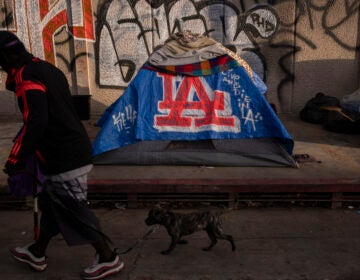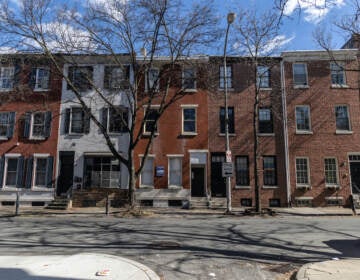From panhandling to a paycheck: How day labor can provide opportunity to Philly’s homeless
Work Now, a day-labor program launched a year and a half ago aims to combat panhandling by challenging people holding “will work for food” signs to do just that.
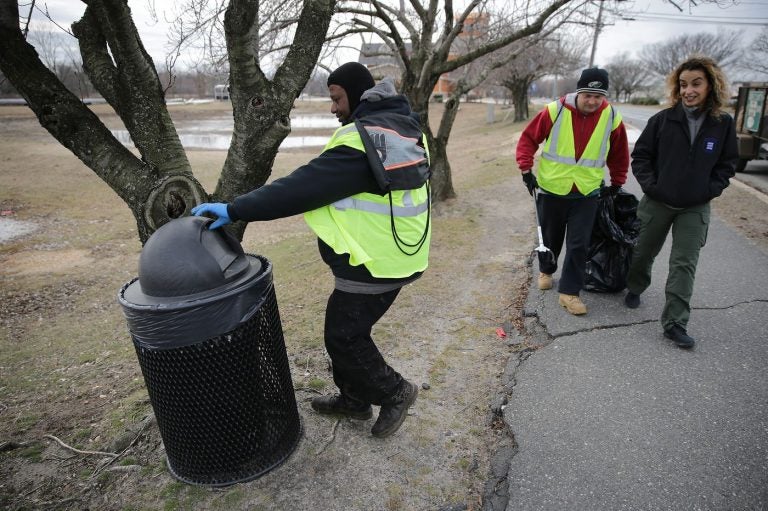
Malcolm Flowers (left) checks a trash can as Cristina "Critt" DeCristofor (right) talks with Kevin Burk while cleaning the area around the Camden County Boathouse in Pennsauken. (David Maialetti/Philadelphia Inquirer)
This article originally appeared on the Philadelphia Inquirer.
—
Six months ago, Duncan Gaskins was homeless, living on the street by the Camden waterfront, desperate for a reason not to backslide to the time when he had found comfort in drugs and security in a gang.
Then, an outreach worker made him an offer: a day’s work, and $75 in his pocket.
Today, Gaskins, 54, has an apartment, a part-time job with Camden County, and a sense of possibility. “It’s no looking back,” he said recently. “I had lost all hope. Through this program, I have renewed hope. It’s still a struggle, but through this, it’s doable.”
That hope-renewing break came in the form of Work Now, a day-labor program the county launched a year and a half ago. Like at least a dozen others in cities around the country, it’s inspired by an initiative Albuquerque, N.M., created in 2015 to combat panhandling by challenging people holding “will work for food” signs to do just that — all while eliminating the barriers associated with more traditional workforce-development programs, like requirements to pass a drug test or present an ID.
Next up: Starting April 1, Philadelphia will get its own day-work program, with a few unique twists.
It’s the first of its kind to offer work making public art, rather than picking up trash, pulling weeds, or other manual labor. It’s the first to enlist peer specialists, individuals who themselves have serious mental illnesses or histories of substance abuse and are trained to support others. And, unlike many other day-work programs around the country — some of which launched in cities like Lexington, Ky., and Portland, Maine, after outright bans on panhandling were overturned in court — organizers insist it is not intended to clear the streets but to offer an opportunity for those who choose to take it.
The Philadelphia program is also unusual in that it is not, for the most part, publicly funded. It will be run by Mural Arts Philadelphia and the nonprofit Mental Health Partnerships, with two years of funding — $300,000 — from philanthropy, primarily the Barra and Sheller foundations. It will operate five days a week, paying 10 workers a day $50 in cash to paint a mural in the SEPTA concourse.
“We want people to see their potential and assign a value to what they’re doing, and try to shift how they see themselves psychologically,” Mural Arts executive director Jane Golden said.
The idea was rooted in feedback gathered by Mental Health Partnerships staff, who were contracted by Rittenhouse Square-area residents in August 2017 to conduct 10 months of homeless outreach to people panhandling in the area. It turned out more than 60 percent of those they approached were not, in fact, homeless.
“There was a larger population who had housing but didn’t have all they needed to make ends meet,” MHP’s Catherine Sui said. “It was really about economic insecurity.”
That’s when they began looking at Work Now, which has employed 396 homeless people in Camden County for at least a day’s work, and connected 127 to additional services. Three participants, including Gaskins, have graduated to a second-tier program the county created six months ago, Bridge to Work, that provides permanent part-time employment through Camden County College.
“I just couldn’t believe it,” said Samantha Matlin, director of evaluation and community impact at the Scattergood Foundation, who researched Work Now to guide development of the Philadelphia project. “The researcher in me was like: ‘I don’t know if this is real. These guys’ lives have totally changed in six months?’ ”
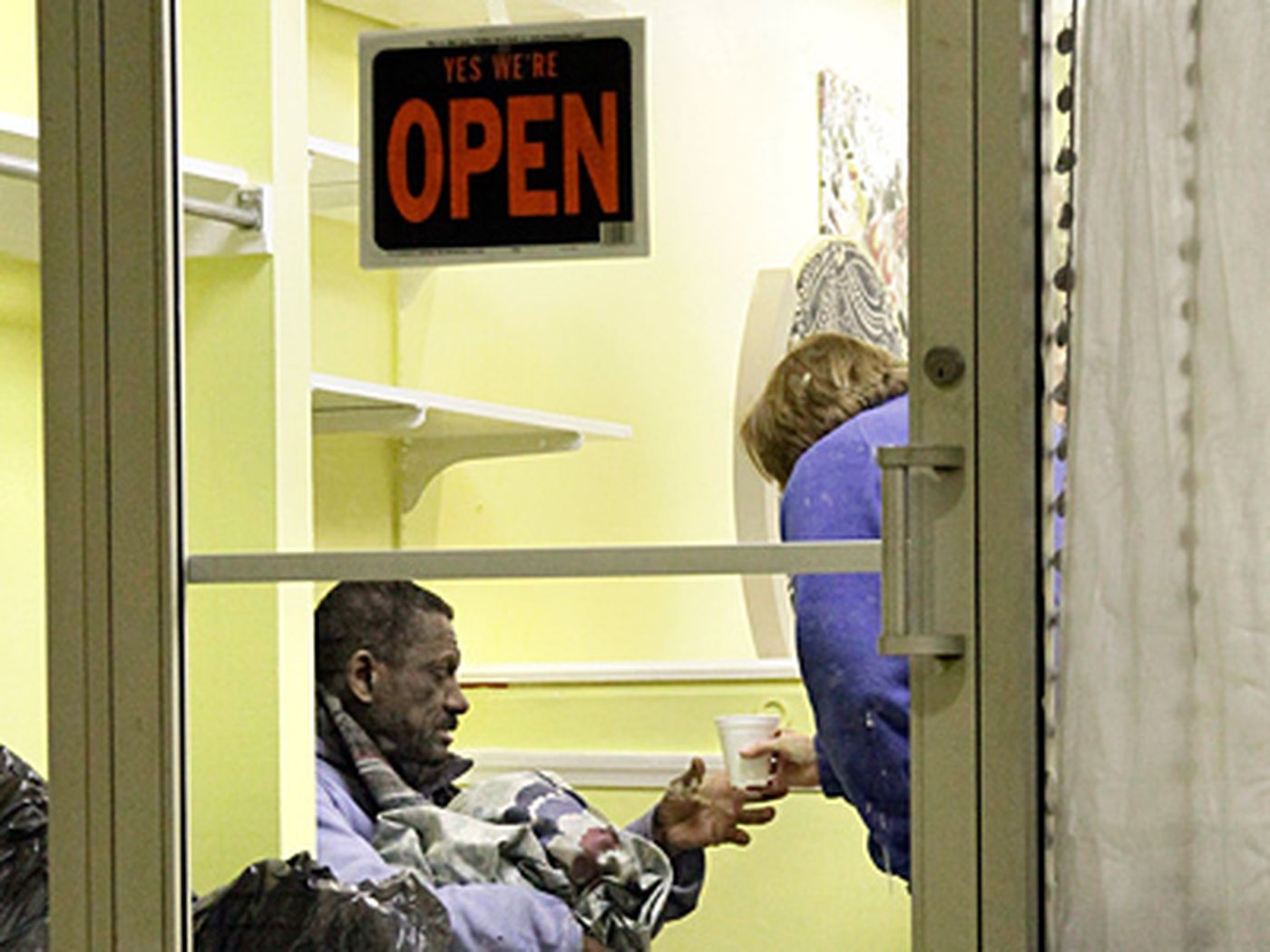
Camden County set aside $90,000 in the first year for a nonprofit contractor, Volunteers of America, to run that program, though administrators had doubts: Will it be safe? Who will be liable? How would these individuals spend the money? But they found the workers were diligent — sometimes even more so than the full-time employees — and the anticipated problems just didn’t arise.
“The one issue we had is how many people want to participate,” said Sharon Bean, who helps administer that program. “There is overwhelming demand.”
She said what makes the program work is the focus on removing barriers to employment: If you’re not visibly intoxicated, you’re in.
A greater logistical challenge was creating opportunities to transition to permanent jobs, she said. It took seven months of discussions with Camden County College, which had to relax its background checks, before Bridge to Work finally launched.

But that opportunity made all the difference for Malcolm Flowers, 54, who was on parole, unemployed and homeless, when he was introduced to Work Now. (The one job he had found was out of county, he said, so his parole officer nixed it.)
Now, after starting with Work Now and graduating to Bridge to Work, he’s saved up enough that he’s about to sign a lease on his own place. Flowers said it’s hard to overstate the impact on his life (though he’s willing to try). “This program is like sunshine,” he said. “You’re living in darkness, and then you have sunshine.”
Philadelphia has some other “low-barrier employment” programs for homeless individuals. One, run by Project HOME and the Free Library, employs people as bathroom monitors and as dishwashers in the library’s Culinary Literacy Center — while also serving as mentors who can provide outreach to homeless library patrons.
Jennifer Chang, chief of the library’s central public services division, said some participants have moved on to permanent housing or other jobs. “I can say this is really a very effective process for them to get help, to build up job skills, and become independent.” She said the program is grant-based, but the library is seeking support to sustain and expand it.
Mural Arts and MHP are still working out details of the Philadelphia program, like how participants will be referred — possibly out of the Hub of Hope homeless services center. (Project HOME, which runs that center with the city, did not respond to requests for comment; the city departments of behavioral health and of homeless services both declined comment.) But they have a wall, and they’ve booked lead artists Michelle Oosterbaan, a painter, muralist, and art professor at local colleges, and Alvin Tull, whose first introduction to murals was working on a piece on the city’s Ridge Shelter, where he was staying before that work helped him transform his life.
Laure Biron, who heads the Mural Arts Porch Light program, a collaboration with the city Department of Behavioral Health and Intellectual disAbility Services, said she expects the program in Philadelphia will reach people like Flowers, who are ready to work, but also people with more challenges.
“This is a good opportunity for someone who is not ready or not in a position to take on full-time work,” she said. “We can help build some of the future-ready skills that would help prepare people for the next step.”
That next step might be a job with an organization like Ready Willing and Able or First Step Staffing — programs that pair employment with supports such as housing, transportation, and job coaching.
All that sounded great to Edwin Allen, 25, who was sitting atop a trash bag filled with blankets in the Suburban Station concourse Tuesday morning. Allen has been homeless for nine months, living on the street with his wife because they haven’t been able to secure a place in a couple’s shelter. He’s applied for jobs — but the problem is, he lost his ID and getting it replaced has been a long, complicated process.
When he gets desperate, he panhandles. But he’d rather work. That $50 a day would be enough to get him on track.
“I just need a job,” he said. “I’ve never had a [steady] job before.”
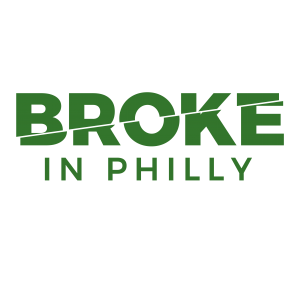 Philadelphia Media Network is one of 22 news organizations producing Broke in Philly, a collaborative reporting project on solutions to poverty and the city’s push toward economic justice. See all of our reporting at brokeinphilly.org.
Philadelphia Media Network is one of 22 news organizations producing Broke in Philly, a collaborative reporting project on solutions to poverty and the city’s push toward economic justice. See all of our reporting at brokeinphilly.org.
WHYY is your source for fact-based, in-depth journalism and information. As a nonprofit organization, we rely on financial support from readers like you. Please give today.


